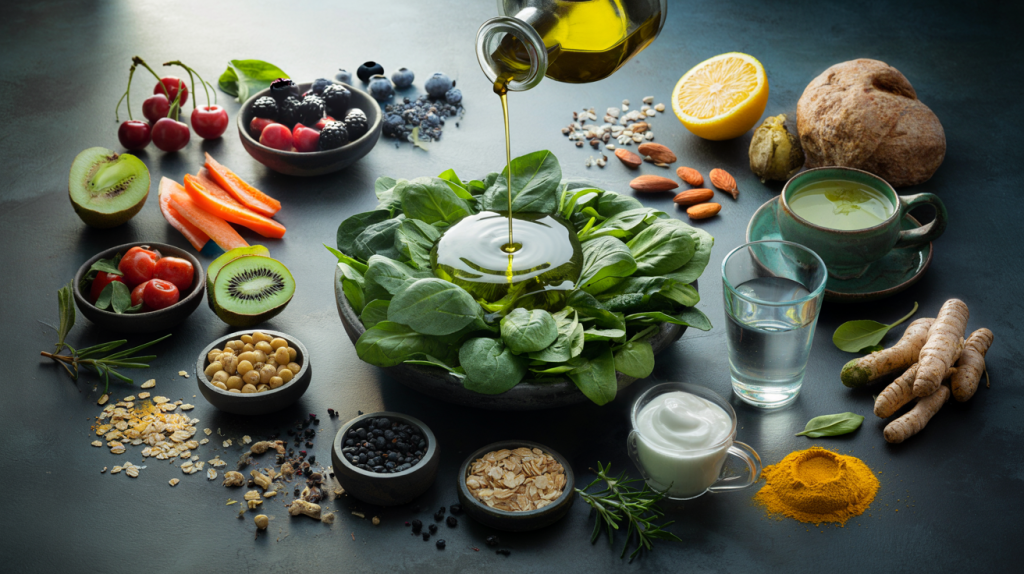Clicked to find the best anti aging foods. Good call. The quickest wins come from the plate, not a miracle cream. Certain nutrients help skin stay firm, calm inflammation and support a longer, healthier life.
Here is what the evidence says. Large trials and cohort studies have linked olive oil, berries, nuts, legumes, leafy greens and fermented foods to better markers of aging, from fewer wrinkles to lower risk of chronic disease. No jargon. Just clear choices that can slot into a normal day.
Anti aging foods and the evidence that actually matters
Skin ages faster with chronic inflammation and oxidative stress. Diets rich in plants tend to dial both down and support collagen and elastin. That is the core idea.
In 2013, a randomized trial in the New England Journal of Medicine reported that a Mediterranean style diet with extra virgin olive oil or nuts cut major cardiovascular events by about 30 percent versus a low fat plan. Cardiovascular aging sets the pace for the rest of the body, which explains the interest around olive oil and walnuts.
Fiber counts too. A 2019 series in The Lancet that pooled data from 185 studies linked high fiber intakes to a 15 to 30 percent lower risk of all cause and cardiovascular mortality compared with low intakes. More beans, whole grains, fruit and veg. Simple.
Antioxidants, collagen and skin glow in daily life
Vitamin C helps build collagen inside the dermis. In 2007, the American Journal of Clinical Nutrition reported that higher vitamin C intake was associated with fewer wrinkles and less dryness in middle aged women. Citrus, kiwifruit, peppers and broccoli deliver the dose the skin uses.
The color of berries signals polyphenols that fight oxidative stress. A 2019 trial in the American Journal of Clinical Nutrition found that daily blueberry intake improved endothelial function and lowered systolic blood pressure by around 5 mmHg over six months in adults with metabolic syndrome. Better blood flow means better nutrient delivery to the skin.
Collagen peptides have also shown promise. In 2015, Skin Pharmacology and Physiology reported that 2.5 to 5 grams per day improved skin elasticity after four weeks, with effects in women aged 35 to 55. It is a food derived ingredient, often from fish or bovine sources, mixed into drinks.
Longevity on a plate with olive oil, nuts and legumes
Healthy fats protect cells from wear. Extra virgin olive oil brings polyphenols like hydroxytyrosol that support HDL function. The Mediterranean model uses it every day for cooking and dressings, which keeps saturated fat lower without losing flavor.
Nuts bring plant protein, magnesium and vitamin E. Replacing a small share of animal protein with plant protein was linked to lower mortality in a 2016 JAMA Internal Medicine analysis. Substituting just 3 percent of energy from animal protein with plant protein corresponded to a 10 percent lower risk of death in large US cohorts.
Legumes fill the gap at lunch or dinner with fiber and resistant starch that feed gut microbes. Diversity in the gut has been associated with healthier aging in observational work, and legumes improve that diversity through fermentation in the colon.
Your smart shopping list for anti aging eating
One change a day compounds fast. Swaps beat overhauls. Here is a compact list to steer the cart.
- Extra virgin olive oil for cooking and salads
- Blueberries, blackberries or cherries frozen or fresh
- Leafy greens like spinach, kale and arugula
- Citrus, kiwifruit and red peppers for vitamin C
- Walnuts and almonds unsalted
- Oats, barley and whole grain bread high in fiber
- Chickpeas, lentils and black beans
- Tomatoes and carrots for carotenoids
- Green tea for catechins
- Yogurt or kefir with live cultures
- Herbs and spices like turmeric and rosemary
- Optional collagen peptides 2.5 to 5 g daily
Results need a little patience. Skin renews over weeks, arteries over months. The timeline is normal. What helps is building a routine that sticks on busy days.
A practical frame works well. Aim for a palm sized portion of protein from fish, legumes or tofu. Fill half the plate with colorful veg. Add a thumb of olive oil and a small handful of nuts. Choose whole grains for the remaining space. This ratio quietly hits fiber, polyphenols and healthy fats without counting.
Numbers keep it real. The Mediterranean pattern in the 2013 trial was not low calorie. It was high in olive oil at roughly 4 tablespoons per day or a daily nut mix of 30 grams. The 2019 fiber analysis pointed toward about 25 to 29 grams of fiber per day as a feasible target. Blueberry benefits in the 2019 study showed up at one cup per day. That is concrete.
Two common mistakes slow progress. Chasing supplements while meals stay low in plants, and cutting fat across the board. Skin and hormones need fat. The pivot is to swap saturated sources for olive oil and nuts while keeping protein and fiber high. It feels more satisfying too, which helps stick with it. It is definitly easier to repeat.
Small anchors help during travel or stress. Keep frozen berries for mornings, canned beans for quick salads, and a bottle of robust olive oil on the counter. The pattern holds even when life gets loud, which is when aging pressures usually rise.
